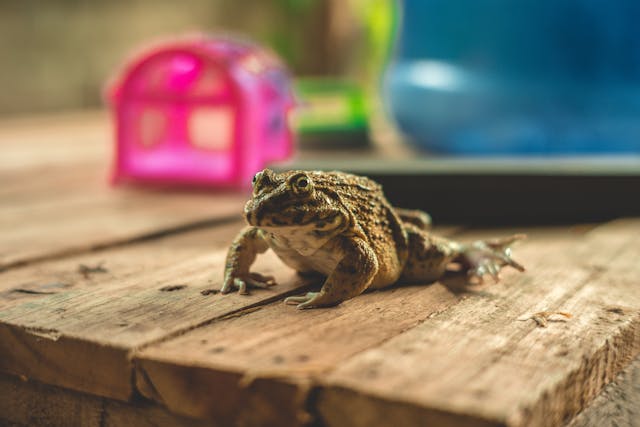While frogs are not cuddly animals, they can make great pets for the right people. Typically, children are intrigued by these tiny specimens. Often kids come across frogs in the garden before they see him them in a pet shop. If you’re a parent, you might be asked by your child for permission to bring one into the house and keep it in their bedroom.
Before you start to feel squeamish, you should know they can make very good animal companions for your youngster. The key is for you and your kid to learn about how to care for them properly and know what to expect. With the right approach, a pet frog can be just the ticket to teach your offspring how to be proper pet parent. Here are frog ownership basics.
Frogs as Pets
Frogs held in captivity can live quite a few years. Their life span ranges from four to 15 years or more depending on the species, so prepare to have your amphibian for a long time. That cute tiny frog you see in the pet store can grow to quite a size. Consider the Pyxicephalus adspersus, nickname “pixie,” a species of bullfrog that puts on a lot of weight and is 8 to 9 inches at maturity.
The largest frogs are usually sedentary, while the smaller varieties are more active. A frog’s skin is very sensitive, so they shouldn’t be handled much. Furthermore, handwashing is a must after picking them up to avoid the risk of salmonella. Although frogs aren’t as expressive as other types of pets, caring for your frog can create a strong attachment.
Frog Fact-Finding
One thing to know about frogs is that many species are on the wildlife endangered list. Various human activities have put them at risk, and numerous organizations are dedicated to reversing the decline of frog populations. Regrettably, these species are sometimes sold as pets. So, read up on the kinds of frogs that are threatened to make sure you aren’t inadvertently buying one of these. There are many species of frog that are bred commercially for the purpose of being pets.
Purchasing Your First Frog
Frogs are susceptible to certain diseases, and that’s a reason to purchase your pet frog at a reputable pet store or from a local breeder. Before being put on the market, these frogs are tested to make sure they are disease-free. Avoid capturing a wild frog outside your house because you can’t be sure that they aren’t sick. Plus, the specimens in your garden are hard at work taking care of the environment, and you don’t want to disrupt the good they’re doing.
Fashioning a Frog Habitat
Frogs require a good-sized aquarium or tank, about 10 to 20 gallons, that is outfitted to replicate their natural environment. Note that some frogs are climbers, so you will want to pick a taller tank. Make their habitat comfortable with a pool of water and a land area with sand, solid rock, peat moss, small tree branches and plants. Put in a few small boxes or other hiding places where the frog can go for privacy.
Having the proper temperature and right humidity level in the aquarium is critical. For instance, above 70 percent humidify is generally recommended for tropical frogs. Temperature requirements could be 75 to 85 Fahrenheit in the daytime and 68 Fahrenheit at night. Learn the needs of the species you adopt. Lighting turned on during the day will mimic the outdoors. Because frogs cannot tolerate contaminants in their surroundings, you will need to clean their habitat and enclosure regularly.
Feeding Your Frog
Frog food depends on the kind of frog you have. Most frogs are carnivores, so they are used to catching and eating live prey. Caterpillars, crickets, grasshoppers, moths, and worms are all fair game. You can buy live prey in a pet shop or stick to commercially made food. You can support your frog’s nutritional needs by adding a multivitamin power and calcium to live food. Whatever you do, be sure not to offer your frog any human food.
Frogs don’t eat every day. Young frogs should be feed every two or three days, six while adults eat two or three times a week. Your frog will need a ready supply of fresh water, which can be provided in a water bowl, a water feature in the tank, or a misting system.
Frog Care
Enlist the assistance of a veterinarian who specializes in amphibians if you notice any worrisome behavior or changes in appearance. Note if your frog seems to be losing their appetite, unable to catch the live prey you put in their tank, not able to jump or having trouble defecating. Watch out, as well, for a change in the shape of their jaw, a cloacal prolapse related to defecating or reddening skin.
Finally
By choosing a species wisely, learning all about frog care and following through, you and your family members may find a frog makes the perfect pet.

